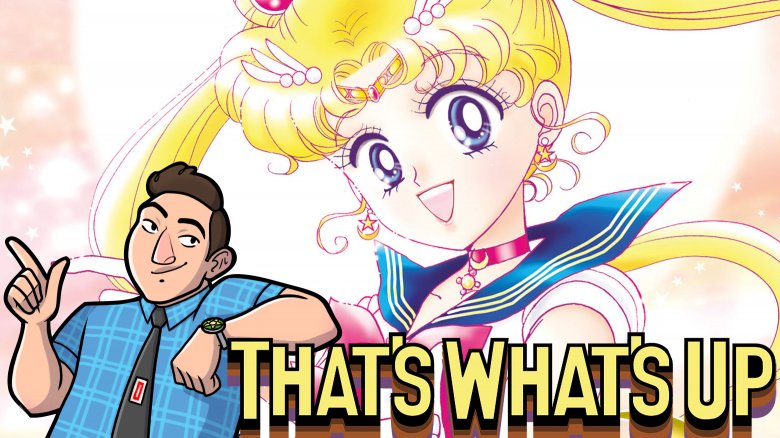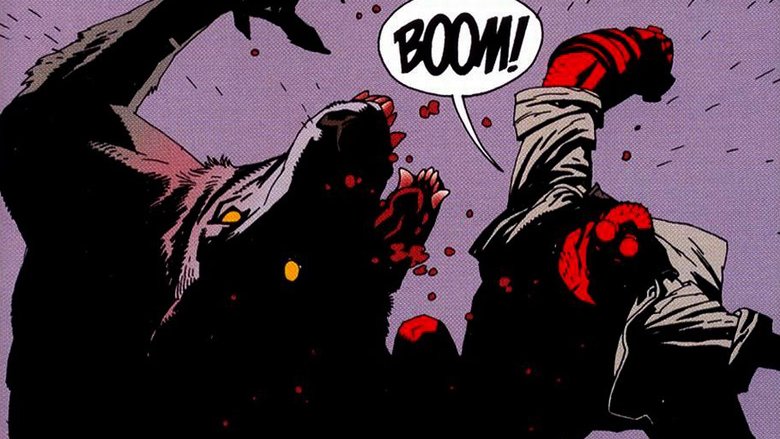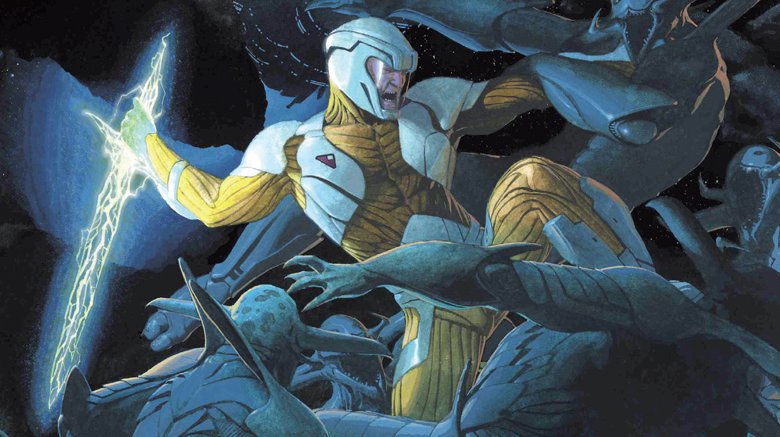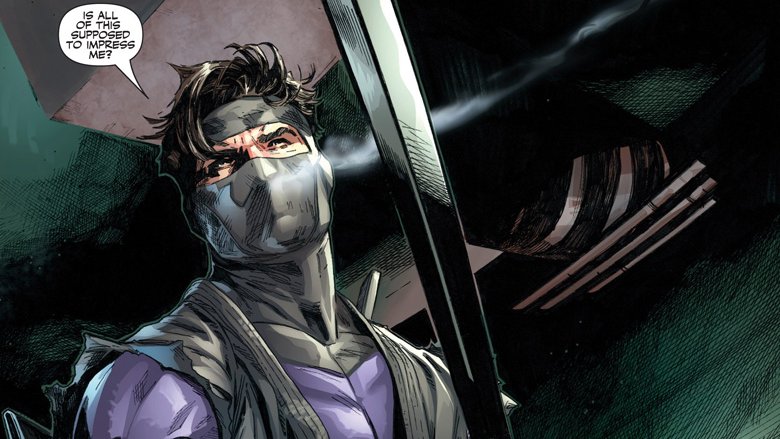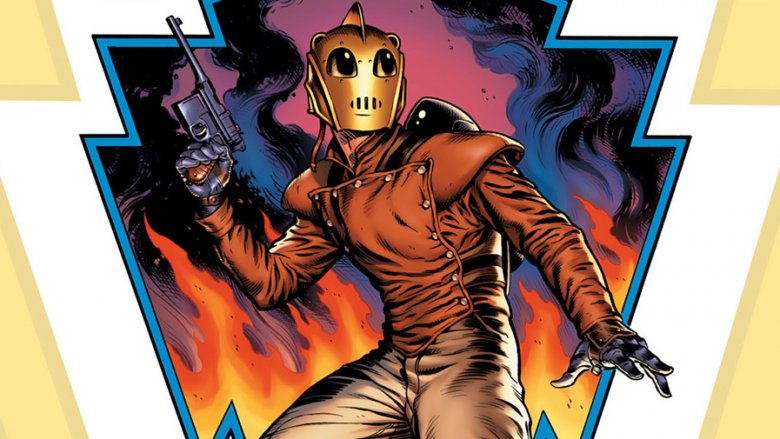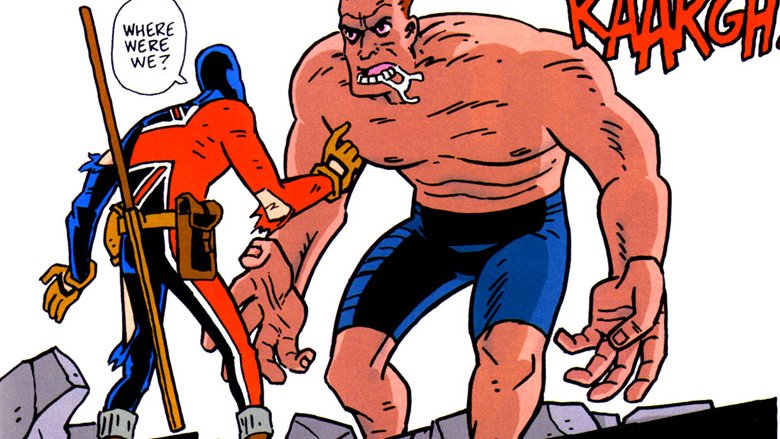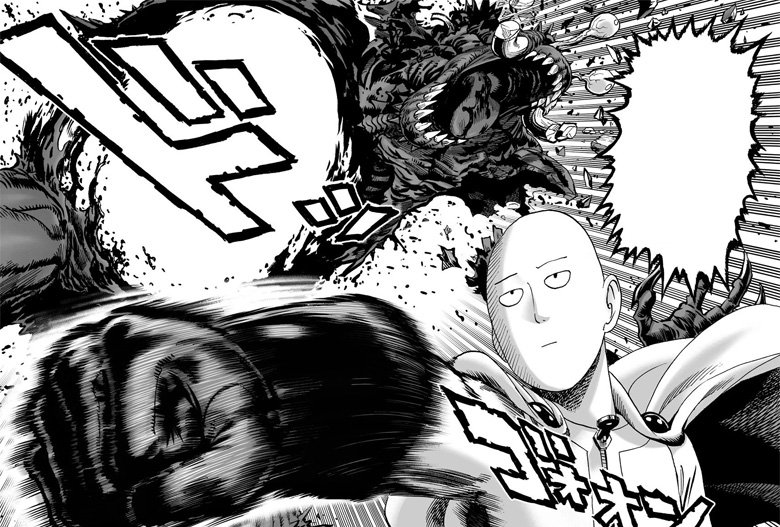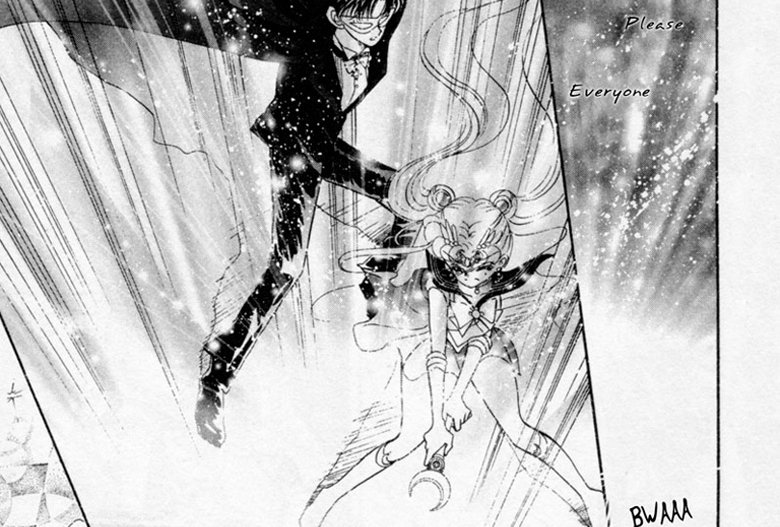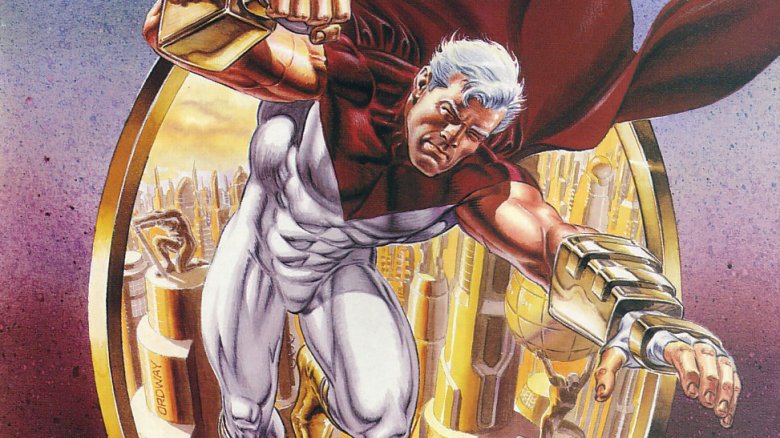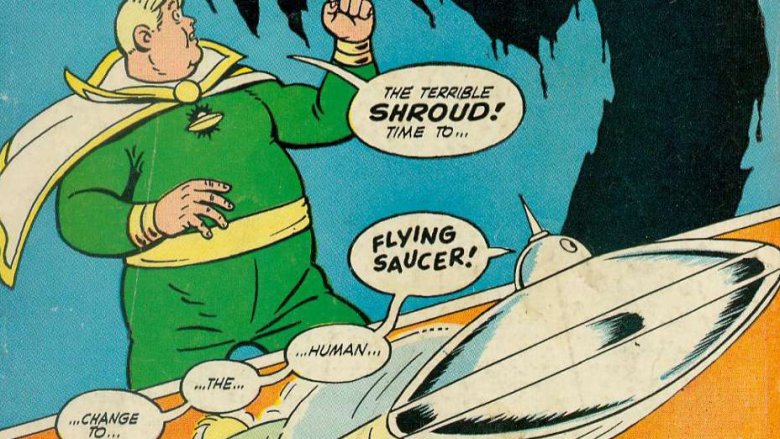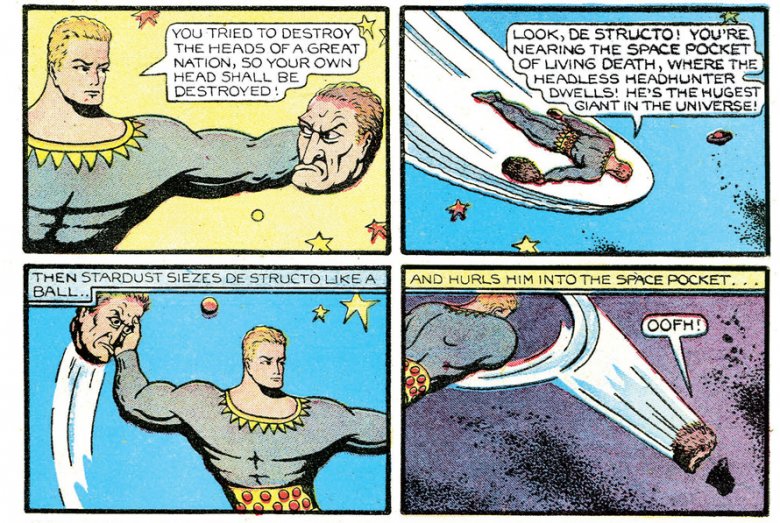That's What's Up: Awesome Superheroes Not From DC Or Marvel
Each week, comic book writer Chris Sims answers the burning questions you have about the world of comics and pop culture: what's up with that? If you'd like to ask Chris a question, please send it to @theisb on Twitter with the hashtag #WhatsUpChris, or email it to staff@looper.com with the subject line "That's What's Up."
Q: Marvel and DC have the big names, but are there other awesome superheroes from beyond the big two? — via email
Comics can lend themselves to any number of stories, from romance to horror to sports to tales of high-stakes cooking battles, but superheroes are the genre that's native to the medium. Because of that, and because they were kind of the only thing you could get in mainstream comics for so long—in America, at least—they were what the language of comics was built around. With that in mind, it's not surprising that you'd see the same sorts of ideas and tropes showing up in places that went far beyond Marvel and DC. There's a lot of great stuff in there, and even more if you count all the stories that are heavily influenced by capes and cowls, even if they tend to be more strongly identified with other genres.
Which I think means that we're about to have the ol' "is Hellboy a superhero?" argument again. Folks, I've got other things to do today, so you're going to have to trust me on this one: he absolutely is.
Hellboy
Despite the fact that the Hellboy books are mostly known for moody atmosphere and stories inspired by folktales, there's an undeniable strain of superhero that runs through his saga that's every bit as prominent as the horror elements. That's not just me saying that, either. If you head back and look at the first volume, you'll find that Mike Mignola dedicated it to H.P. Lovecraft and Jack Kirby, and if there's nothing more "moody, atmospheric horror" than Lovecraft, there's definitely nothing more superhero than Jack Kirby.
Hellboy exists as this perfect synthesis of those two ideas. The atmosphere and imagery is horror, from werewolves to ghosts to children being replaced by changelings and all the way down to a descent into Hell itself, but the structure? The visual language? The extended shared universe that allows the B.P.R.D. to deal with its own threats in Hellboy's absence? That's all superhero stuff, and so is the part where Hellboy faces off with supernatural creatures and mostly solves everyone's problems by punching them in the face. And all of it combines to make some of the best stories comics have ever seen.
I've talked about "The Corpse" before, but that thing—a story originally told in two-page installments about Hellboy rescuing a child from the Sidhe by carrying a corpse all across Ireland and encountering an entire country's worth of obstacles drawn from folklore—is about as perfect as comic stories get. The thing is, it's not the exception, it's the rule. So if there's any other debate about whether he counts, consider this: he might not wear a cape, but Hellboy does get into fistfights with Nazi Frankenstein gorillas. If that's not the sign of a superhero, I don't know what is.
X-O Manowar
X-O Manowar, created by Jim Shooter, Steve Englehart, Bob Layton, and Barry Windsor-Smith in 1992, is the flagship character at Valiant Comics. And he's also legitimately one of the best high concept ideas that superheroes have ever seen.
Here's the short version: Aric of Dacia is a visigoth at war with the Roman Empire in the year 402 AD. Unfortunately, before he can get in on the big sack of Rome in 410, an alien race called the Vine comes to Earth, attacking Aric's visigoths and enslaving them for labor aboard their spaceship. Also on the spaceship: an incredibly powerful suit of high-tech armor that's part weapon, part religious artifact. Needless to say, Aric ends up getting control of it and makes his way back to Earth, only to find that his time in space and the tricky nature of relativity mean that his return comes 1,600 years after he left. Which also means that the Vine has been seeding a conquest of the planet through sleeper agents for quite a while.
In other words, that dude is Conan the Barbarian with a suit of Iron Man armor, and that's rad.
Ninjak
While we're on the subject of Valiant Comics, I'd be remiss if I didn't mention their other truly amazing high-concept mash-up character, Ninjak. This time, the big idea is "what if James Bond was Batman," with every bit of weirdness that you get from dressing a hyper-competent, ludicrously wealthy socialite up in a purple ninja costume so he can take out the enemies of the crown.
Colin King is the son of a family so rich that he literally lives in a castle. Or, at least, he did until it was blown up by villains working for the mysterious Master Darque, whose name has probably led you to the correct conclusion that he's a very bad man. King's talents extend beyond his ancestral estate, though: he's also a highly trained ninja who lends his services to the British government as a freelance secret agent. In fact, he's the 11th ninja they've had on the roster, with each one being distinguished by a letter. He's Ninja-K, get it?
That's a setup that lends itself pretty well to over-the-top action, and the book certainly delivers on that front with adventures that take Ninjak everywhere from undercover in an organization that designs super-weapons to journeying to a magical realm called the Deadside. And it also features some of the most psychologically engaging stories of the past decade—no, really. That dude rules every bit as hard as you'd expect someone named "Ninjak" to rule, which is quite a bit.
The Rocketeer
While the Rocketeer is probably best known for its 1991 movie adaptation, the original comics are some of the best adventure stories of the '80s. Created by Dave Stevens, the Rocketeer's adventures were marked by lavish, expressive art and an incredibly thrilling, pulp-inspired storyline.
If you've never read it—and if you managed to miss out on the movie—The Rocketeer is exactly what it says on the tin. Cliff Secord is an ace stunt pilot working for an air circus, dealing with a fiery temper and an endless amount of insecurity leading to a rocky relationship with his girlfriend, Betty—heavily inspired by pin-up queen Bettie Page, with whom Stevens would become friends and eventually even help to get royalties from publishers using her photos. On top of that, he gets caught up in a series of adventures when he stumbles across a jetpack that allows him to take to the air as a rocket-powered crimefighter, and that everyone from Hitler to J. Edgar Hoover seems to want for their own purposes.
It's full of great action, but the best thing about it might be the way that Stevens effortlessly weaves Cliff Secord into the tapestry of American pulp heroes. Over the course of his adventures, the Rocketeer brushed up against characters like Doc Savage and the Shadow, who were disguised just enough (and frequently unnamed) to avoid any legal trouble. Between that and Stevens' mastery of serial-style cliffhangers, the whole thing seems less like a throwback and more like a synthesis of what made those stories work so well in the first place, given a whole new energy through Stevens' masterpiece.
All things considered, there's not a lot of Rocketeer out there—the whole series fits into a single paperback volume—but what is there is good enough that pound for pound, it's one of the best comics ever.
Jack Staff
I mentioned Jack Staff in my rundown of my favorite comics of all time, but it always bears repeating that it's the best.
At the risk of repeating myself, while Jack himself is a great character with an incredible hook—he was Britain's Greatest Hero for decades, but 20 years ago, he stopped showing up and everyone sort of forgot about him, and nobody knows why—but what makes him work is that he doesn't exist in isolation. Instead, he's at the center of an entire universe of fascinating heroes, villains, and characters that exist in that strange space in between.
The pithy way to say it is that Jack Staff might actually be the worst character in Jack Staff, but there's an equally pithy counterpoint to that one, too: the worst character in Jack Staff is still better than the best character in most other comics.
One Punch Man
Great superheroes aren't just limited to western comics, and while the shonen manga genre might have its own sets of traditions and tropes, there are more than a few Japanese heroes who fit right in alongside their American counterparts. Kamen Rider and Astro Boy, for instance, are two of the all-time greats, but in more recent years, the most prominent has been Saitama, better known to readers as One Punch man.
The concept here is simple: he's a hero strong enough to defeat any enemy, no matter how world-shatteringly powerful, with a single punch. As a result, he's usually far more concerned with picking up vegetables on sale at his local grocery store than with actually battling the forces of evil. There's just no challenge in it.
The thing is, while it might seem like a joke—and while there's plenty of humor to go around in the stories—it's easy to argue that One Punch Man is the best pure superhero comic being published today. ONE and Yusuke Murata have built a universe around their title hero to justify the endless series of demons and monsters that Saitama takes on, and in the process, they've created a compelling story with a fantastic cast of characters. They've even given us some of the best fight scenes on either side of the Pacific... although as you might expect, they do tend to be a little short.
Sailor Moon
While most people are probably more familiar with it from the anime series that made her a household name in the '90s, Sailor Moon has her origins in the comics by Naoko Takeuchi—and those comics have everything.
Talking cats! Reincarnated princesses! Destined moon lovers! Monstrous mothers! Weird prototype characters that raise a lot of questions about the time stream that the narrative is not equipped to handle! Major villains being burnt to a crisp and straight up murdered with lightning bolts by schoolgirls! Enemies from the distant past! Children from the far future! Tiaras used as boomerangs! And crystals... so many crystals.
Throw in a main character defined by eating, sleeping, and taking the easy way out—truly an example that we can all aspire to live up—and you've got one of the greatest superhero sagas of all time.
Supreme
Forget about Watchmen and throw The Killing Joke straight out the window: if you really want to experience Alan Moore's greatest work in comics, you need to go straight to Supreme.
Supreme was originally created by Rob Liefeld, but after taking over the series with #41 in 1996, Moore, Joe Bennett, Keith Giffen, and Rick Veitch reimagined him as an undisguised and unabashed take on Superman. They used him as a medium to explore ideas about what it meant for a character to be rebooted and changed over and over again throughout the years, linking a Silver Age aesthetic to decidedly modern stories—and while that metatextual idea is right there at the center of the book, it never feels like they're just commenting on comics. Instead, they're using those ideas to build something that's not just a tribute to the Silver Age, but that stands on its own so well that many readers consider it to be the greatest Superman story ever told.
The thing is, though, it's not a Superman story at all. It can't be. By using an analog character like Supreme, the creators were able to tell the kind of story that you could never really tell with Superman himself, if only because it would require breaking the entire universe around him and rebuilding it to pull it off. In this book, though, they're able to build it as they go, standing on the shoulders of decades worth of familiar imagery to do something that goes far beyond being just a tribute.
Fatman, the Human Flying Saucer
Okay, this is where it gets weird.
In the 1940s, Otto Binder and C.C. Beck were the primary creators behind Captain Marvel—better known today as Shazam—a character who was so popular that at the height of his popularity, he was outselling Superman. By the '50s, Binder would go on to become unquestionably the greatest Superman writer of all time, penning some of the era's most memorable stories and co-creating characters and concepts like Bizarro, the Legion of Super-Heroes, Brainiac, Krypto the Super-Dog, and, perhaps most importantly, Supergirl.
Then, in 1967, Binder and Beck reunited for a new creation, and ended up with one of the strangest comics ever printed.
The hero this time—sporting a suspiciously Captain Marvel-esque costume, albeit one wrapped around a much portlier frame—was Fatman, the Human Flying Saucer, who was billed as the only hero with three identities. In his day-to-day life, he was a wealthy but aimless dilettante named Van Crawford, whose hefty frame was so dense as to make him functionally invulnerable. Then, he met (and rescued!) an alien who taught him how to shape-shift into a flying saucer, because honestly, at this point, why not. Thus, three separate identities, contained in issues that, at 64 all-new pages each, were about three times longer than any other comics on the stands.
It may not shock you to discover that this series only lasted for three issues.
Stardust the Super Wizard
Of course, if you really want to see some weird comics, you've got to go all the way back to the Golden Age. The first few years after Superman exploded onto the scene and made everyone realize that they could make a whole lot of money with this new kind of character is full of staggeringly bizarre stuff, mostly because it's being created by people who had no idea what the rules of this new medium should be. And Stardust, who debuted in 1939, puts them all to shame.
He is, of course, Super Wizard, although what exactly that means is never really explained in the comics. Instead, you get lines about how he's "a master mind of the universe with a mysterious knowledge of criminals" and that "interplanetary science has made him the most remarkable man that ever lived." So, you know. There's that.
In terms of the stories, this translates into some buck wild crimefighting. In his first appearance, he throws an entire gang of spies out of a window, hanging them in place with an anti-gravity ray and then, with zero explanation, causing the skeletons of their victims to materialize next to them while a bunch of G-Men look on and comment that "something strange is going on." In a later story, in what is probably his most famous moment, he deals with a racketeer by causing his body to shrivel up until he's just a scowling head, and then throwing that head into space where it's absorbed by a monster that doesn't have a head, but can eat a head by putting it onto its own headless shoulders.
If that sentence doesn't make sense, don't worry: the comic it's describing doesn't make a whole lot of sense either. But that doesn't mean it's not awesome.
Each week, comic book writer Chris Sims answers the burning questions you have about the world of comics and pop culture: what's up with that? If you'd like to ask Chris a question, please send it to @theisb on Twitter with the hashtag #WhatsUpChris, or email it to staff@looper.com with the subject line "That's What's Up."
